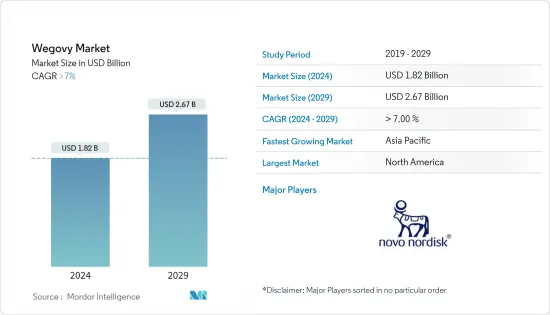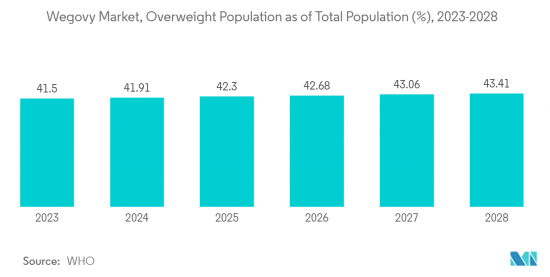
|
市場調査レポート
商品コード
1408864
ウゴービ:市場シェア分析、産業動向・統計、2024~2029年成長予測Wegovy - Market Share Analysis, Industry Trends & Statistics, Growth Forecasts 2024 - 2029 |
||||||
カスタマイズ可能
適宜更新あり
|
|||||||
| ウゴービ:市場シェア分析、産業動向・統計、2024~2029年成長予測 |
|
出版日: 2024年01月04日
発行: Mordor Intelligence
ページ情報: 英文 70 Pages
納期: 2~3営業日
|
- 全表示
- 概要
- 目次
ウゴービ市場の規模は2024年に18億2,000万米ドルと推定され、2029年には26億7,000万米ドルに達すると予測され、予測期間中(2024~2029年)のCAGRは7%を超える成長率で推移する見込みです。

WEGOVY(セマグルチド)注射剤2.4mgは、12歳以上の肥満症(成人はBMI 30以上、小児はBMI 95パーセンタイル以上)または体重超過(BMI 27以上)の成人で、体重に関連する持病を有する人の減量とその維持を支援する注射剤です。最適な結果を得るためには、ウゴービはカロリーを抑えた食事計画と身体活動の増加とともに使用する必要があります。
ウゴービはセマグルチドを含有しており、セマグルチドを含有する他の製品または他のGLP-1受容体作動薬と併用してはならないです。他の処方薬、市販薬、またはハーブの減量製品と併用した場合のウゴービの安全性と有効性は不明です。さらに、ウゴービが膵炎の既往歴のある人に安全に使用できるかどうかは不明です。さらに、12歳未満の小児に対するウゴービの安全性と有効性は確立されていません。
米国疾病予防管理センター(CDC)によると、肥満は様々な健康合併症を引き起こす可能性のある病状です。米国では42%以上が肥満であり、カリフォルニア州では30~35%が肥満です。肥満の判定に使われるのは、身長に対する体重を評価する体格指数(BMI)です。BMIが25~30を太りすぎ、30を超えると肥満に分類されます。
数多くの種類の処方減量薬が、減量のプロセスを助けるために異なる方法で機能します。一般的に12週間未満の短期使用を目的とした薬もあれば、長期間使用できる薬もあります。これらの減量薬の多くには、関連する副作用があることに注意することが重要です。
オゼンピックの背後にある製薬会社はまた、最近大きな注目を集めているウゴービと呼ばれる人気の減量薬を作りました。ウゴービは、長期的な体重管理を目的としたFDA認可の週1回注射薬で、この種の薬としては2014年以降初めて認可されました。ウゴービもオゼンピックも有効成分としてセマグルチドを含むが、ウゴービは高用量で減量に特化した製剤であるのに対し、オゼンピックは2型糖尿病患者向けでセマグルチドの用量が低いです。
サクセンダとウゴービは、同じGLP-1受容体作動薬です。食欲を減退させ、食後の満腹感を増大させることで効果を発揮します。サクセンダが1日1回注射するのに対し、ウゴービは週1回注射します。一方、Qsymiaはカプセル剤、Contraveは錠剤で、それぞれ1日1回服用します。これらの薬はサクセンダやウゴービとは作用が異なり、脳内のさまざまなメッセージ経路に作用して食欲や食への渇望を抑えます。米国消化器病学会の最近のガイドラインによると、ウゴービは、ほとんどの人にとって、サクセンダ、Qsymia、Contraveよりも減量効果が高い可能性があります。しかし、2型糖尿病患者については、ウゴービによる体重減少が少ないことが研究で示されているため、この限りではないかもしれないです。
したがって、この市場は、有病率の増加と前述の要因により、分析期間中に成長すると予想されます。
ウゴービ市場の動向
世界の肥満有病率の上昇が予測期間中の市場を牽引
肥満の蔓延は公衆衛生分野における重要な問題であり、ほぼすべての国に影響を及ぼしています。過去30年間、肥満率は右肩上がりで推移しており、ほぼすべての地域で、肥満の人が低体重の人を上回っています。この動向が続けば、2025年には世界人口の12%にあたる10億人の成人が肥満の影響を受けると予測されています。
BMIは、成人および小児の過体重と肥満を評価し、特定するための貴重なツールです。BMIは、個人の体重(キログラム)を身長(メートル)の2乗で割って算出されます。BMIは体脂肪率と密接な関係があります。過度の脂肪蓄積は、様々な健康合併症の可能性を大幅に増加させる可能性があります。個人のBMIを評価することにより、ヘルスケア専門家は、その体重が彼らの全体的な幸福に潜在的なリスクをもたらすかどうかを確認することができます。
世界肥満連盟(WOF)が2023年3月に発表した報告書によると、2035年までに世界人口の半数以上(40億人以上)が肥満になると予測されています。UCLAフィールディング公衆衛生大学院の助教授であり、ロナルド・レーガンUCLAメディカルセンターの臨床入院栄養士でもあるダナ・ハネス博士によれば、肥満の増加は世界の食生活の変化に起因しているといいます。報告書はまた、肥満率が特に低所得国の子供たちの間で急速に増加しており、今後10年間で2億人以上の男子と1億7,000万人以上の女子が影響を受ける可能性があることを強調しています。
さらに、同じく世界肥満連盟が発表した『World Obesity Atlas 2023』では、予防・治療対策が改善されなければ、太りすぎと肥満による経済的影響は2035年までに年間4兆3,200億米ドルに達すると予測しています。これは世界のGDPの3%近くを占め、2020年のCOVID-19の影響に匹敵します。報告書は、肥満の予防と管理のための新しいWHO勧告を実施する上で、国の行動計画とユニバーサル・ヘルス・カバレッジの重要性を強調しています。
肥満率は上昇傾向にあり、2030年までに世界の肥満者数は2010年から倍増すると予測されています。肥満の減少が進んでいないことが懸念されるが、各地域にはそれぞれの事情があります。欧州と北米の一部では、肥満率は高い水準にあるもの、横ばいになりつつあります。一方、低・中所得諸国(LMICs)や小島嶼開発途上国(SIDS)では、肥満率が最も急速に増加しており、すでに栄養不良に対処している国々にさらなるプレッシャーを与えています。
肥満率が最も高いのは、男女ともにWHOの南北アメリカ地域です。しかし、南北アメリカでは2010年から2030年の間に肥満が1.5倍に増加すると予測されているのに対し、アフリカでは2030年までに3倍に増加すると予測されています。つまり、アフリカの肥満男性は2010年の800万人から2030年には2,700万人に、肥満女性は2010年の2,600万人から2030年には7,400万人に増加すると予測されています。特筆すべきは、アジアとアフリカには、全世界の太りすぎの子どものほぼ4分の3が住んでいるということです。

予測期間中、北米地域が最も高い成長率を示す見込み
2023年11月、ノボ・ノルディスク社は、米国で減量治療薬ウゴービを処方されている保険加入患者のかなりの部分が、薬代として毎月25米ドル未満しか支払っていないと発表しました。これは、保険に加入しているアメリカ人のほとんどが、定価1ヶ月約1350米ドルのウゴービの費用を全額負担していないことを示しています。米国の多くの保険会社が、ウゴービやその他の肥満治療薬の高額な費用をカバーすることに躊躇し、保険プランからの除外につながっているこの時期に、この事実が明らかになった。しかし、これらの治療薬に対する需要は全米で増加の一途をたどっており、入手可能な供給量を上回っています。
ノボ・ノルディスクの北米担当副社長ダグ・ランガ氏は、11月2023年第3四半期の決算説明会で、ほとんどの主要医療保険制度と薬局給付管理会社がウゴービの保険適用を行っていると述べた。ランガ氏は、ウゴービを保険適用にしない雇用主もいることを認めつつも、全体的な動向として、週1回の注射を保険適用にする保険会社が増加していることを強調しました。ランガ氏は、約5,000万人の肥満のあるアメリカ人が、健康保険でウゴービの保険適用を受けられる可能性があると推定しました。
ほとんどの健康保険プランでは、医学的に必要と判断された糖尿病治療薬はカバーされるのが普通です。メディケアも糖尿病治療薬をカバーしており、米国糖尿病協会(American Diabetes Association)は、メディケアと糖尿病の処方薬給付に関する有用なガイドを提供しています。保険に加入している患者さんは、処方薬の自己負担額という形で自己負担額を支払うことになります。複数の薬が必要な場合、毎月の自己負担額は200米ドル以上になることもあります。
前述のような要因が、市場の成長を後押ししています。
ウゴービ産業の概要
ウゴービ市場は、ノボ・ノルディスク1社によって高度に統合されています。2032年までに特許が切れるため、ジェネリック医薬品の参入が予想されます。
その他の特典:
- エクセル形式の市場予測(ME)シート
- 3ヶ月間のアナリストサポート
目次
第1章 イントロダクション
- 調査の前提条件と市場定義
- 調査範囲
第2章 調査手法
第3章 エグゼクティブサマリー
第4章 市場力学
- 市場概要
- 市場促進要因
- 市場抑制要因
- ポーターのファイブフォース分析
- 供給企業の交渉力
- 消費者の交渉力
- 新規参入業者の脅威
- 代替品の脅威
- 競争企業間の敵対関係の強さ
第5章 市場セグメンテーション
- 医薬品
- 医薬品
- 地域
- 北米
- 米国
- カナダ
- その他北米地域
- 欧州
- ドイツ
- 英国
- フランス
- ロシア
- スペイン
- イタリア
- その他の欧州
- アジア太平洋
- インド
- 中国
- 日本
- 韓国
- オーストラリア
- ベトナム
- マレーシア
- インドネシア
- フィリピン
- タイ
- その他のアジア太平洋地域
- ラテンアメリカ
- ブラジル
- メキシコ
- その他のラテンアメリカ
- 中東・アフリカ
- エジプト
- サウジアラビア
- イラン
- 南アフリカ
- オマーン
- その他の中東とアフリカ
- 北米
第6章 市場指標
- 1型糖尿病人口
- 2型糖尿病人口
第7章 競合情勢
- 企業プロファイル
- Novo Nordisk A/S
第8章 市場機会と今後の動向

The Wegovy Market size is estimated at USD 1.82 billion in 2024, and is expected to reach USD 2.67 billion by 2029, growing at a CAGR of greater than 7% during the forecast period (2024-2029).
WEGOVY (semaglutide) injection 2.4 mg is a prescribed injectable medication that can assist individuals aged ≥12 years with obesity (BMI ≥30 for adults, BMI ≥ 95th percentile for age and sex for children) or certain adults with excess weight (BMI ≥27) (overweight) who also have weight-related medical conditions in achieving weight loss and maintaining it. To achieve optimal results, Wegovy should be used with a reduced-calorie meal plan and increased physical activity.
Wegovy contains semaglutide and should not be used with other products containing semaglutide or other GLP-1 receptor agonist medications. The safety and effectiveness of Wegovy when taken alongside other prescription, over-the-counter, or herbal weight loss products is unknown. Additionally, it is uncertain whether Wegovy can be used safely in individuals with a history of pancreatitis. Furthermore, the safety and effectiveness of Wegovy in children under 12 years of age have not been established.
According to the Centers for Disease Control and Prevention (CDC), obesity is a medical condition that can result in various health complications. In the United States, over 42% of individuals are affected by obesity, while in California, the prevalence of obesity ranges from 30-35%. The measurement used to determine obesity is the body mass index (BMI), which assesses a person's weight relative to their height. A BMI between 25-30 is classified as overweight, whereas a BMI exceeding 30 is categorized as obesity.
Numerous varieties of prescription weight-loss medications function in distinct ways to aid in the process of losing weight. Certain drugs are intended for short-term usage, typically less than 12 weeks, while others can be utilized for extended durations. It is important to note that many of these weight loss medications may have associated side effects.
The pharmaceutical company behind Ozempic has also created a popular weight-loss medication called Wegovy, which has gained significant attention recently. Wegovy is an FDA-approved weekly injection designed for long-term weight management, making it the first drug of its kind to be approved since 2014. Both Wegovy and Ozempic contain semaglutide as their active ingredient, but Wegovy has higher doses and is specifically formulated for weight loss, while Ozempic is intended for individuals with type 2 diabetes and has lower doses of semaglutide.
Saxenda and Wegovy are both GLP-1 receptor agonists in the same drug group. They work by reducing appetite and increasing the feeling of fullness after eating. While Saxenda is injected once daily, Wegovy is injected once weekly. On the other hand, Qsymia and Contrave come in capsule and tablet forms, respectively, and are taken once a day. These drugs work differently from Saxenda and Wegovy by affecting various message pathways in the brain to reduce appetite and food cravings. According to recent guidelines from the American Gastroenterological Association, Wegovy might be more effective for weight loss than Saxenda, Qsymia, or Contrave for most people. However, this may not be the case for those with type 2 diabetes, as studies have shown that they lose less weight with Wegovy.
Therefore, the market studied is anticipated to grow over the analysis period due to increased prevalence and the aforementioned factors.
Wegovy Market Trends
Rising Obesity prevalence globally is driving the market over the forecast period
The prevalence of obesity is a significant issue in the public health sector, impacting nearly every nation. Over the past thirty years, obesity rates have been on a steady incline, with more individuals living with obesity than those who are underweight in almost every region. If this trend persists, it is projected that up to 1 billion adults, or 12% of the global population, are expected to be affected by obesity by 2025.
BMI serves as a valuable tool for assessing and identifying overweight and obesity in both adults and children. It is calculated by dividing an individual's weight in kilograms by the square of their height in meters. BMI is closely associated with the level of body fat present. Excessive fat accumulation can significantly increase the likelihood of various health complications. By evaluating an individual's BMI, healthcare professionals can ascertain whether their weight poses potential risks to their overall well-being.
A report released by the World Obesity Federation (WOF) in March 2023 predicts that by 2035, more than half of the world's population, which is over 4 billion people, will be obese. The increase in obesity is attributed to changes in diet worldwide, according to Dana Hunnes, Ph.D., an assistant professor at the UCLA Fielding School of Public Health and a clinical inpatient dietitian at Ronald Reagan UCLA Medical Center. The report also highlights that obesity rates are rapidly increasing among children, particularly in lower-income countries, and could affect over 200 million boys and 170 million girls in the next decade.
Furthermore, the World Obesity Atlas 2023, also published by the World Obesity Federation, predicts that if preventive and treatment measures are not improved, the economic impact of overweight and obesity will reach USD 4.32 trillion annually by 2035. This accounts for nearly 3% of the global GDP, comparable to the impact of COVID-19 in 2020. The report emphasizes the significance of national action plans and Universal Health Coverage in implementing the new WHO Recommendations for the Prevention and Management of Obesity.
Obesity rates are on the rise, and it is projected that by 2030, the global number of individuals with obesity will have doubled since 2010. Although the lack of progress in reducing obesity is a concern, each region has its unique situation. In certain parts of Europe and North America, obesity rates are beginning to level off, albeit at a high level. On the other hand, Low- and Middle-Income Countries (LMICs), as well as Small Island Developing States (SIDS), are experiencing the fastest increase in obesity rates, which adds additional pressure to countries already dealing with malnutrition.
The highest rates of obesity are still observed in the WHO Americas region for both men and women. However, while the Americas are expected to see a 1.5-fold increase in obesity between 2010 and 2030, the numbers in Africa are projected to triple by 2030. This means that the number of obese men in Africa is estimated to increase from 8 million in 2010 to 27 million in 2030, while the number of obese women is expected to rise from 26 million in 2010 to 74 million in 2030. It is worth noting that Asia and Africa are home to nearly three-quarters of all overweight children worldwide.

The North American region is Expected to Witness Highest Growth Rate Over the Forecast Period
In November 2023, Novo Nordisk announced that a significant portion of insured patients in the United States who are prescribed weight loss treatment, Wegovy, are paying less than USD 25 per month for the medication. This indicates that most insured Americans are not burdened with the full cost of Wegovy, which has a list price of approximately USD 1,350 per month. This revelation comes at a time when many health insurers in the U.S. are hesitant to cover the high cost of Wegovy and other obesity drugs, leading to their removal from insurance plans. However, the demand for these treatments continues to rise across the country, surpassing the available supply.
Doug Langa, the Vice President for North America at Novo Nordisk, stated during a third-quarter earnings call on November 2023 that most major health plans and pharmacy benefit managers provide coverage for Wegovy. While Langa acknowledged that some employers choose not to include Wegovy in their coverage, he highlighted that the overall trend shows an increasing number of insurers opting to cover the weekly injection. Langa estimated that approximately 50 million Americans with obesity could potentially qualify for Wegovy coverage under their health plans.
Most health insurance plans typically cover diabetes medications as they are deemed medically necessary. Medicare also provides coverage for diabetes medications, and the American Diabetes Association offers a helpful guide on Medicare and prescription drug benefits for diabetes. Patients with insurance can expect to pay out-of-pocket costs in the form of prescription drug copays, which can range from USD 10 to USD 50, depending on the specific medication. In cases where multiple drugs are required, monthly copays can add up to USD 200 or more.
The aforementioned factors are set to boost the market growth.
Wegovy Industry Overview
Wegovy Market is highly consolidated with one player, Novo Nordisk. The market is anticipated to witness the entry of generic players in the Wegovy Drug Market by 2032, as the patent is set to expire.
Additional Benefits:
- The market estimate (ME) sheet in Excel format
- 3 months of analyst support
TABLE OF CONTENTS
1 INTRODUCTION
- 1.1 Study Assumptions and Market Definition
- 1.2 Scope of the Study
2 RESEARCH METHODOLOGY
3 EXECUTIVE SUMMARY
4 MARKET DYNAMICS
- 4.1 Market Overview
- 4.2 Market Drivers
- 4.3 Market Restraints
- 4.4 Porter's Five Forces Analysis
- 4.4.1 Bargaining Power of Suppliers
- 4.4.2 Bargaining Power of Consumers
- 4.4.3 Threat of New Entrants
- 4.4.4 Threat of Substitute Products and Services
- 4.4.5 Intensity of Competitive Rivalry
5 MARKET SEGMENTATION
- 5.1 Drug
- 5.1.1 Wegovy
- 5.2 Geography
- 5.2.1 North America
- 5.2.1.1 United States
- 5.2.1.2 Canada
- 5.2.1.3 Rest of North America
- 5.2.2 Europe
- 5.2.2.1 Germany
- 5.2.2.2 United Kingdom
- 5.2.2.3 France
- 5.2.2.4 Russia
- 5.2.2.5 Spain
- 5.2.2.6 Italy
- 5.2.2.7 Rest of Europe
- 5.2.3 Asia Pacific
- 5.2.3.1 India
- 5.2.3.2 China
- 5.2.3.3 Japan
- 5.2.3.4 South Korea
- 5.2.3.5 Australia
- 5.2.3.6 Vietnam
- 5.2.3.7 Malaysia
- 5.2.3.8 Indonesia
- 5.2.3.9 Philippines
- 5.2.3.10 Thailand
- 5.2.3.11 Rest of the Asia-Pacific
- 5.2.4 Latin America
- 5.2.4.1 Brazil
- 5.2.4.2 Mexico
- 5.2.4.3 Rest of Latin America
- 5.2.5 Middle East and Africa
- 5.2.5.1 Egypt
- 5.2.5.2 Saudi Arabia
- 5.2.5.3 Iran
- 5.2.5.4 South Africa
- 5.2.5.5 Oman
- 5.2.5.6 Rest of the Middle-East and Africa
- 5.2.1 North America
6 MARKET INDICATORS
- 6.1 Type 1 Diabetes Population
- 6.2 Type 2 Diabetes Population
7 COMPETITIVE LANDSCAPE
- 7.1 COMPANY PROFILES
- 7.1.1 Novo Nordisk A/S


